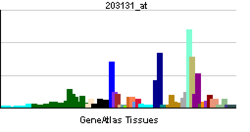- PDGFRA
-
Alpha-type platelet-derived growth factor receptor is a protein that in humans is encoded by the PDGFRA gene.
This gene encodes a cell surface tyrosine kinase receptor for members of the platelet-derived growth factor family. These growth factors are mitogens for cells of mesenchymal origin. The identity of the growth factor bound to a receptor monomer determines whether the functional receptor is a homodimer or a heterodimer, composed of both platelet-derived growth factor receptor alpha and beta polypeptides. Studies in knockout mice, where homozygosity is lethal, indicate that the alpha form of the platelet-derived growth factor receptor is particularly important for kidney development since mice heterozygous for the receptor exhibit defective kidney phenotypes.[1]
Contents
Interactions
PDGFRA has been shown to interact with PDGFRB,[2][3] PLCG1,[4] Sodium-hydrogen antiporter 3 regulator 1,[5] Cbl gene,[6] CRK,[7][8] Caveolin 1[9] and PDGFC.[10]
See also
References
- ^ "Entrez Gene: PDGFRA platelet-derived growth factor receptor, alpha polypeptide". http://www.ncbi.nlm.nih.gov/sites/entrez?Db=gene&Cmd=ShowDetailView&TermToSearch=5156.
- ^ Rupp, E; Siegbahn A, Rönnstrand L, Wernstedt C, Claesson-Welsh L, Heldin C H (Oct. 1994). "A unique autophosphorylation site in the platelet-derived growth factor alpha receptor from a heterodimeric receptor complex". Eur. J. Biochem. (GERMANY) 225 (1): 29–41. doi:10.1111/j.1432-1033.1994.00029.x. ISSN 0014-2956. PMID 7523122.
- ^ Seifert, R A; Hart C E, Phillips P E, Forstrom J W, Ross R, Murray M J, Bowen-Pope D F (May. 1989). "Two different subunits associate to create isoform-specific platelet-derived growth factor receptors". J. Biol. Chem. (UNITED STATES) 264 (15): 8771–8. ISSN 0021-9258. PMID 2542288.
- ^ Eriksson, A; Nånberg E, Rönnstrand L, Engström U, Hellman U, Rupp E, Carpenter G, Heldin C H, Claesson-Welsh L (Mar. 1995). "Demonstration of functionally different interactions between phospholipase C-gamma and the two types of platelet-derived growth factor receptors". J. Biol. Chem. (UNITED STATES) 270 (13): 7773–81. doi:10.1074/jbc.270.13.7773. ISSN 0021-9258. PMID 7535778.
- ^ Maudsley, S; Zamah A M, Rahman N, Blitzer J T, Luttrell L M, Lefkowitz R J, Hall R A (Nov. 2000). "Platelet-Derived Growth Factor Receptor Association with Na+/H+ Exchanger Regulatory Factor Potentiates Receptor Activity". Mol. Cell. Biol. (UNITED STATES) 20 (22): 8352–63. doi:10.1128/MCB.20.22.8352-8363.2000. ISSN 0270-7306. PMC 102142. PMID 11046132. http://www.pubmedcentral.nih.gov/articlerender.fcgi?tool=pmcentrez&artid=102142.
- ^ Bonita, D P; Miyake S, Lupher M L, Langdon W Y, Band H (Aug. 1997). "Phosphotyrosine binding domain-dependent upregulation of the platelet-derived growth factor receptor alpha signaling cascade by transforming mutants of Cbl: implications for Cbl's function and oncogenicity". Mol. Cell. Biol. (UNITED STATES) 17 (8): 4597–610. ISSN 0270-7306. PMC 232313. PMID 9234717. http://www.pubmedcentral.nih.gov/articlerender.fcgi?tool=pmcentrez&artid=232313.
- ^ Yokote, K; Hellman U, Ekman S, Saito Y, Rönnstrand L, Saito Y, Heldin C H, Mori S (Mar. 1998). "Identification of Tyr-762 in the platelet-derived growth factor alpha-receptor as the binding site for Crk proteins". Oncogene (ENGLAND) 16 (10): 1229–39. doi:10.1038/sj.onc.1201641. ISSN 0950-9232. PMID 9546424.
- ^ Matsumoto, T; Yokote K, Take A, Takemoto M, Asaumi S, Hashimoto Y, Matsuda M, Saito Y, Mori S (Apr. 2000). "Differential interaction of CrkII adaptor protein with platelet-derived growth factor alpha- and beta-receptors is determined by its internal tyrosine phosphorylation". Biochem. Biophys. Res. Commun. (UNITED STATES) 270 (1): 28–33. doi:10.1006/bbrc.2000.2374. ISSN 0006-291X. PMID 10733900.
- ^ Yamamoto, M; Toya Y, Jensen R A, Ishikawa Y (Mar. 1999). "Caveolin is an inhibitor of platelet-derived growth factor receptor signaling". Exp. Cell Res. (UNITED STATES) 247 (2): 380–8. doi:10.1006/excr.1998.4379. ISSN 0014-4827. PMID 10066366.
- ^ Gilbertson, D G; Duff M E, West J W, Kelly J D, Sheppard P O, Hofstrand P D, Gao Z, Shoemaker K, Bukowski T R, Moore M, Feldhaus A L, Humes J M, Palmer T E, Hart C E (Jul. 2001). "Platelet-derived growth factor C (PDGF-C), a novel growth factor that binds to PDGF alpha and beta receptor". J. Biol. Chem. (United States) 276 (29): 27406–14. doi:10.1074/jbc.M101056200. ISSN 0021-9258. PMID 11297552.
Further reading
- Hart CE, Bowen-Pope DF (1990). "Platelet-derived growth factor receptor: current views of the two-subunit model". J. Invest. Dermatol. 94 (6 Suppl): 53S–57S. doi:10.1111/1523-1747.ep12875065. PMID 2161888.
- Corless CL, Schroeder A, Griffith D, et al. (2005). "PDGFRA mutations in gastrointestinal stromal tumors: frequency, spectrum and in vitro sensitivity to imatinib". J. Clin. Oncol. 23 (23): 5357–64. doi:10.1200/JCO.2005.14.068. PMID 15928335.
- Lasota J, Miettinen M (2007). "KIT and PDGFRA mutations in gastrointestinal stromal tumors (GISTs)". Semin Diagn Pathol 23 (2): 91–102. doi:10.1053/j.semdp.2006.08.006. PMID 17193822.
This article incorporates text from the United States National Library of Medicine, which is in the public domain.
Protein kinases: tyrosine kinases (EC 2.7.10) Receptor tyrosine kinases (EC 2.7.10.1) Insulin receptor familyPDGF receptor familyFGF receptor familyVEGF receptors familyHGF receptor familyTrk receptor familyEPH receptor familyLTK receptor familyLTK · ALKTIE receptor familyROR receptor familyROR1 · ROR2DDR receptor familyPTK7 receptor familyRYK receptor familyMuSK receptor familyROS receptor familyAATYK receptor familyAXL receptor familyRET receptor familyuncatagorisedNon-receptor tyrosine kinases (EC 2.7.10.2) ABL familyACK familyACK1 · TNK1CSK familyFAK familyFES familyFRK familyJAK familySRC-A familySRC-B familyTEC familySYK familyB enzm: 1.1/2/3/4/5/6/7/8/10/11/13/14/15-18, 2.1/2/3/4/5/6/7/8, 2.7.10, 2.7.11-12, 3.1/2/3/4/5/6/7, 3.1.3.48, 3.4.21/22/23/24, 4.1/2/3/4/5/6, 5.1/2/3/4/99, 6.1-3/4/5-6 Receptors: growth factor receptors Type I cytokine receptor Receptor protein serine/threonine kinase Receptor tyrosine kinase Fibroblast growth factor (1, 2, 3, 4)
Nerve growth factors: high affinity Trk (TrkA, TrkB, TrkC)
Somatomedin (Insulin-like growth factor 1)
VEGF (1, 2, 3)Tumor necrosis factor receptor Ig superfamily Other/ungrouped B trdu: iter (nrpl/grfl/cytl/horl), csrc (lgic, enzr, gprc, igsr, intg, nrpr/grfr/cytr), itra (adap, gbpr, mapk), calc, lipd; path (hedp, wntp, tgfp+mapp, notp, jakp, fsap, hipp, tlrp) Categories:- Human proteins
- Chromosome 4 gene stubs
Wikimedia Foundation. 2010.

